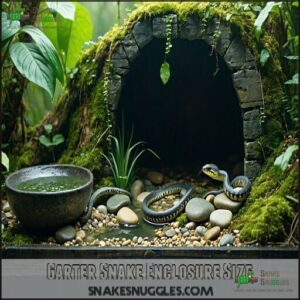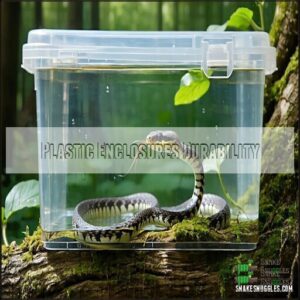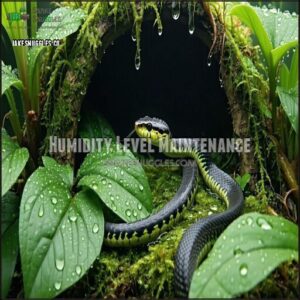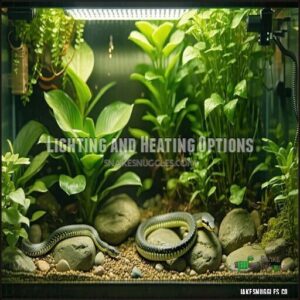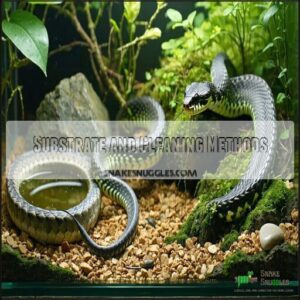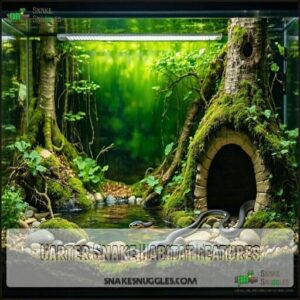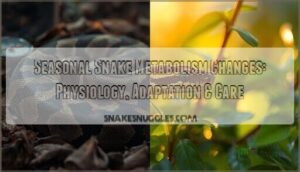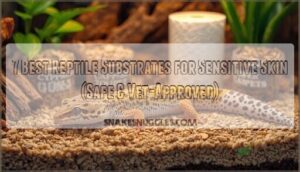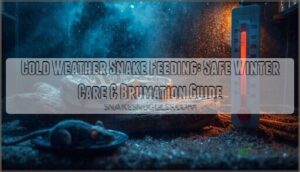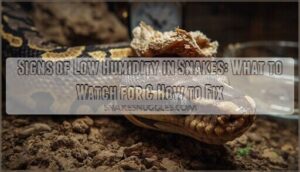This site is supported by our readers. We may earn a commission, at no cost to you, if you purchase through links.
 Creating the perfect garter snake habitat is easier than you’d think, and it’s all about balance.
Creating the perfect garter snake habitat is easier than you’d think, and it’s all about balance.
Start with a secure enclosure—glass or plastic works well—sized for your snake (about a 20-gallon tank for adults).
Add a soft, absorbent substrate like aspen shavings or paper towels to keep things cozy and clean.
Maintain a temperature gradient of 75–85°F, with a basking spot around 90°F, and keep humidity at 40–60%.
A water dish big enough for soaking, plus hides and branches, offers comfort and enrichment.
Think of it as designing a mini jungle retreat—functional, but with a touch of flair to keep your snake thriving!
Table Of Contents
- Key Takeaways
- Garter Snake Enclosure Size
- Enclosure Materials Selection
- Environmental Conditions Setup
- Substrate and Cleaning Methods
- Garter Snake Habitat Features
- Frequently Asked Questions (FAQs)
- What is a good habitat for a garter snake?
- How to set up a garter snake tank?
- What kind of bedding for a garter snake?
- Do garter snakes need a heat mat?
- What plants are safe in garter snake habitats?
- How to manage odors in snake enclosures?
- Can garter snakes be kept in bioactive enclosures?
- How to provide enrichment garter snakes?
- Is it safe to use live prey for feeding?
- Conclusion
Key Takeaways
- Keep the enclosure cozy with a temperature gradient of 75-85°F, a basking spot around 90°F, and humidity between 40-60%.
- Use safe, absorbent substrates like aspen shavings, coconut husk, or paper towels, and avoid harmful options like cedar, pine, or sand.
- Add hides, branches, and a water dish for comfort, enrichment, and hydration, mimicking natural habitats.
- Maintain cleanliness by spot-cleaning daily, changing water weekly, and doing a full enclosure deep clean monthly.
Garter Snake Enclosure Size
Choosing the right enclosure size for your garter snake is essential to its health and well-being, as it needs enough space to move freely without feeling exposed.
The right enclosure size ensures your garter snake stays active, secure, and stress-free, promoting a happy and healthy life.
Whether you’re housing a hatchling or an adult, matching the enclosure dimensions to the snake’s size guarantees comfort and security.
Hatchling Enclosure Requirements
Tiny garter snake hatchlings thrive in a small snake habitat, like a five-gallon tank.
This garter snake enclosure size prevents escape and avoids overwhelming them.
Use initial substrate, like paper towels, for easy cleaning, and include hiding spots for enrichment and feeding setups that suit their tiny size.
A snug, well-designed snake habitat guarantees safety and comfort for your new pets.
Adult Enclosure Size Recommendations
As your garter snake grows, their enclosure needs to scale up too!
For a happy adult, aim for at least a 15-gallon reptile terrarium setup, making certain the length plus width exceeds the snake’s length.
Consider tank height—18 inches is just right for proper heating and decorations.
Space optimization enhances their comfort, so make certain the snake habitat design doesn’t feel cramped, ensuring a comfortable environment for your garter snake.
Pair and Breeding Enclosure Needs
When housing breeding pairs, garter snake enclosure size matters.
A 55-gallon tank lets two snakes interact comfortably while minimizing co-habitation stress.
During breeding season prep, make certain hiding spots and proper temperature gradients.
Neonate housing requires smaller spaces post-birth, while egg incubation setup should maintain stable conditions.
Thoughtful snake habitat design supports healthy breeding and seamless reptile terrarium setup practices.
Captive-bred snakes often exhibit better health overall, making them ideal for breeding programs with overall better health.
Enclosure Materials Selection
Choosing the right material for your garter snake’s enclosure is essential for keeping it healthy and secure.
Whether you go with glass, wood, or plastic, each option impacts temperature, humidity, and maintenance in unique ways.
Glass Enclosures Benefits
Glass enclosures shine in many ways.
They offer excellent visibility advantages, letting you admire your garter snake’s habitat easily.
Cleaning ease is a big plus—glass wipes down quickly without trapping grime.
Temperature gradients are simple to manage, thanks to its smooth surface.
Though fragility concerns exist, glass adds aesthetic appeal, making any snake enclosure a centerpiece.
Wood Enclosures Advantages
Wooden enclosures offer exceptional heat retention and moisture control, making them ideal for your garter snake habitat.
They’re sturdy, customizable, and great for aesthetics with natural looks that blend well in any space.
The structural integrity guarantees lasting durability, and you can design them to fit any unique needs.
For enhanced safety, consider using snake-safe materials during construction.
A wood snake enclosure balances function and style beautifully, providing a natural look.
Plastic Enclosures Durability
Plastic enclosures are durable and practical, offering scratch resistance and impact resistance, perfect for a garter snake enclosure.
They handle humidity well, resist chemical degradation, and are lightweight, making setups easier.
Plus, their long-term cost is often lower, and if escapeproof designs matter to you, plastic checks that box too.
Use this snake enclosure size guide to find the right fit.
Environmental Conditions Setup
To keep your garter snake healthy and happy, you’ll need to get the temperature, humidity, and lighting just right.
A proper setup mimics their natural environment, creating comfort and reducing stress.
Temperature Gradient Creation
Creating a proper temperature gradient in your garter snake enclosure guarantees their comfort.
Heat one side with a lamp or mat, setting a basking spot at 85°F, while the cool zone stays around 75°F.
Use thermostats for precise temperature regulation. Many owners find thermostat-related products helpful for this.
Monitor the gradient often—it’s like giving your snake a cozy, reptilian version of heated floors! Keep it consistent!
Humidity Level Maintenance
Keeping humidity for snakes balanced makes their skin soft and helps during shedding.
Use a digital hygrometer to monitor humidity levels, aiming for 35-60%.
A great way to monitor this is with a digital reptile hygrometer.
- Mist the enclosure lightly a few times weekly for steady substrate moisture.
- Set up humid hides filled with sphagnum moss for comfort.
- Avoid constant dampness; snakes dislike soggy digs.
- Increase humidity slightly when shedding.
This adjustment helps snakes during the shedding process, and maintaining the right level of humidity is crucial for their overall health and skin condition, ensuring they have a comfortable environment to live in, with soft skin.
Lighting and Heating Options
Good lighting and heating keep your garter snake healthy and happy.
Set up a basking bulb for warmth and UVB lighting for vitamin D3 synthesis. Use a temperature controller for safety and maintain a thermal gradient.
Pair LED lighting with infrared heat emitters for night use. For consistency, heat mat safety is essential.
Proper setups can be found at online reptile suppliers.
| Feature | Purpose | Example |
|---|---|---|
| Heat Mats | Ground warmth | Under-tank heaters |
| UVB Lighting | Calcium absorption | UVB strip lights |
| Basking Bulbs | Warmth and activity | Halogen or ceramic bulbs |
| Infrared Emitters | Nighttime heating | Ceramic heat emitters |
| Temperature Control | Regulates gradients | Digital thermostats |
Substrate and Cleaning Methods
Choosing the right substrate and keeping it clean are essential for your garter snake’s health and comfort.
With proper materials and a simple cleaning routine, you’ll create a safe, low-maintenance environment that helps your snake thrive, ensuring a healthy space for your pet.
Absorbent Substrate Options
When setting up your garter snake enclosure, choose absorbent substrates like aspen shavings, coconut husk, or cypress mulch for a natural look and easy cleaning.
Paper towels work too, especially for young snakes or frequent cleanups.
Soil mixtures blend well for burrowing and humidity control. The right snake substrate options make your garter snake habitat healthier and more comfortable.
Harmful Substrate Avoidance
You’ve got a long list of snake substrate options, but some are outright no-nos for your garter snake enclosure.
Avoid cedar and pine—they release aromatic oils harmful to their lungs. Sand impaction from calcium sand or silica sand can block their digestion. Gravel? That’s germ central.
Stick with safe choices to keep your snake’s health on solid ground. Absorbent bedding helps control humidity.
- Dangerous materials: Cedar, pine, sand
- Problematic traits: Impaction risks, respiratory issues
- Avoidable elements: Aromatic oils, tough-to-clean surfaces
- Key focus: Safe, digestible, and absorptive substrates
Daily and Monthly Cleaning Routines
Cleaning a snake enclosure isn’t intimidating if you keep a routine. Spot cleaning daily means removing waste and soiled substrate. Change water regularly to prevent bacterial buildup.
Every month, do a deep clean: disinfect surfaces, replace substrate, and rinse decorations. Here’s a quick guide:
| Task | Frequency | Tools Needed | Tip |
|---|---|---|---|
| Spot Cleaning | Daily | Gloves, paper towels | Dispose of waste properly. |
| Water Changes | Weekly | Clean dish, fresh water | Keep water bowl bacteria-free. |
| Deep Cleans | Monthly | Detergent, sponge | Replace all substrate. |
| Disinfect Enclosure | Monthly | Snake-safe disinfectant | Make certain of total dryness before reuse. |
The key to maintaining a clean and healthy environment for your snake is to follow this schedule consistently, ensuring the enclosure remains clean and safe for your pet.
Garter Snake Habitat Features
When setting up a garter snake’s habitat, you’ll want to include features that mimic its natural environment, like water access and secure hiding spots.
Proper lighting and temperature control are essential to keep your snake comfortable, active, and healthy.
Water Feature Incorporation
A water dish for snakes is essential, but adding a small water feature, like a shallow basin, mimics their semiaquatic environment perfectly.
Make certain water depth is safe, shallow enough to avoid accidents.
Keep cleaning frequency high to maintain health, and feature size should allow soaking without crowding.
A stable, secure water source keeps your garter snake happy and hydrated.
Hiding Spot and Decoration Ideas
Creating hiding spots and adding decorations can make your garter snake’s habitat feel like home.
Hiding spots and natural decor transform your garter snake’s habitat into a private, enriching sanctuary for comfort and stimulation.
Try these ideas:
- Use safe plants or opaque backgrounds to provide privacy.
- Add climbing branches or naturalistic decor for enrichment.
- Place snake hides like logs or rocks for comfort.
- Include reptile enrichment items, like tunnels, for mental stimulation.
Keep it cozy and natural!
Natural Lighting and Temperature Cycles
After setting up hiding spots, focus on garter snake lighting to mimic their diurnal rhythm.
Use UVB bulbs for vitamin D synthesis and maintain a temperature gradient with basking spots at 90–95°F.
Adjust light spectrum seasonally for natural daytime conditions.
Night temperatures can drop slightly, promoting healthy basking behavior and aligning with their thermal and seasonal adjustments for comfort.
Garter snakes also benefit from regular substrate changes to prevent bacterial growth.
Frequently Asked Questions (FAQs)
What is a good habitat for a garter snake?
A great garter snake habitat includes a 40-gallon tank, secure lid, temperature gradient (75-85°F), humidity around 50%, hiding spots, and a water dish for soaking.
Use aspen shavings or coconut fiber as substrate.
How to set up a garter snake tank?
Imagine your snake gliding through its new tank.
Start with a 40-gallon enclosure, add aspen bedding, a warm basking spot, hiding spaces, and maintain temperatures between 75-85°F with 35-60% humidity.
What kind of bedding for a garter snake?
You’ll want absorbent, safe bedding like aspen shavings, cypress mulch, or coconut husk.
Avoid cedar or pine, as they’re toxic.
Paper towels work too, especially for easy cleanup, but they’re not the most natural option.
Do garter snakes need a heat mat?
Think of warmth as a garter snake’s invisible hug.
Yes, they need a heat mat to create a cozy basking spot, keeping one side of their enclosure at 85°F for proper digestion and comfort.
What plants are safe in garter snake habitats?
You can safely use pothos, spider plants, bromeliads, and Boston ferns in a garter snake habitat.
These plants thrive in humid conditions, provide shade, and help mimic their natural environment without posing any toxic risks, making them a good choice for a natural environment.
How to manage odors in snake enclosures?
Keep odors in check by spot-cleaning daily, replacing soiled substrate, and ensuring proper ventilation.
Choose absorbent bedding like aspen shavings, avoid overfeeding, and clean the enclosure weekly to keep it fresh and your snake stress-free.
Can garter snakes be kept in bioactive enclosures?
Yes, garter snakes thrive in bioactive enclosures.
With live plants, beneficial microfauna, and the right humidity, it mimics their natural habitat, reduces cleaning, and keeps them engaged.
Just make certain proper ventilation and a sturdy substrate.
How to provide enrichment garter snakes?
Give your garter snake enrichment with climbing branches, water dishes for swimming, and hides for cozy retreats.
Mix up the substrate for burrowing, add safe plants, and rotate decorations to keep things interesting and stimulating!
Is it safe to use live prey for feeding?
Using live prey for feeding is risky—it can injure your snake.
Instead, opt for pre-killed or frozen-thawed prey to guarantee safety, reduce stress, and mimic natural hunting behaviors with creative feeding techniques.
Conclusion
Did you know that garter snakes can thrive up to 10 years or more in a well-maintained habitat?
With these garter snake habitat setup ideas, you’re not just creating an enclosure—you’re crafting a space where your snake can truly flourish.
From choosing the right enclosure size to maintaining the perfect temperature gradient and adding cozy hides, every detail matters.
Keep things simple yet functional, and you’ll have a healthy, happy snake that feels right at home.
- https://zslpublications.onlinelibrary.wiley.com/doi/abs/10.1111/j.1469-7998.2006.00251.x
- https://www.nrcresearchpress.com/doi/abs/10.1139/z89-351
- https://www.nps.gov/articles/000/garter-snake-fast-facts.htm
- https://www.petmd.com/reptile/garter-snake-care-sheet
- https://www.thebiodude.com/blogs/reptile-and-amphibian-caresheets-with-cited-veterinary-and-herpetology-sources/garter-snake-thamnophis-sp-care-sheet-and-guide?srsltid=AfmBOooLP9_upLhcjL8EekgoBRnRagujZFnzhm5pGLw_ro87Vd2kj06Q

